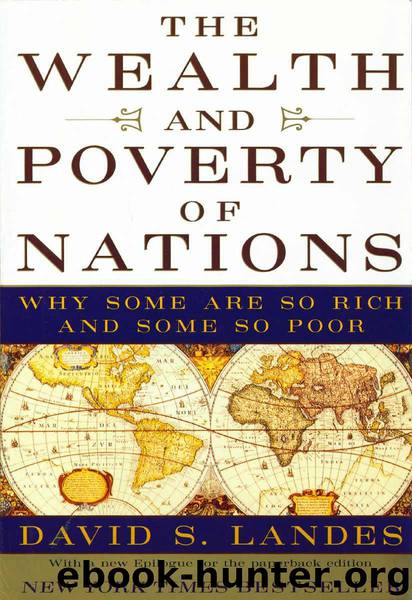The Wealth and Poverty of Nations: Why Some Are So Rich and Some So Poor by Landes David S

Author:Landes, David S. [Landes, David S.]
Language: eng
Format: mobi, epub
Publisher: Norton
Published: 1999-05-16T16:00:00+00:00
First came those tasks ordinary to government: a postal service, a new time standard,* public education (for boys and then for girls as well),† universal military service.** The last two in particular defined the new society. General schooling diffused knowledge; that is what schools are for. But it also instilled discipline, obedience, punctuality, and a worshipful respect for (adoration of) the emperor.3 This was the key to the development of a we/they national identity transcending parochial loyalties and status lines. The nation’s calendar was homogenized around the Tenno cult. Every school had its picture of the emperor, and on every national holiday, the same ritual was performed in front of this icon throughout the country at the same time.
The army (and navy) completed the job. Beneath the sameness of the uniform and the discipline, universal military service wiped out distinctions of class and place. It nurtured nationalist pride and democratized the violent virtues of manhood. In Japan, this meant generalization of the right to fight—an end to the samurai monopoly of arms. (Not every former commoner applauded the change. War and violence had always been the business of the elite, who were duly rewarded with stipends. Many of those too old to have been formed by the new common schools asked why they were now expected to engage in such foolishness. But they would not do the fighting.)
Higher authority saw a citizen army as a prerequisite of power, and power was the primary objective—power to be free, power to talk back to the Europeans, power to push others around the way Europeans did. In September 1871, the new Japan negotiated a treaty with China. The treaty did not accord Japan extraterritorial and commercial privileges like those already granted to the Western powers; but it was signed as between equals. A momentous “first” inequality would come after. This was followed in 1874 by an expedition to Formosa (Taiwan), which in effect affirmed Japanese sovereignty over the Ryukyu Islands and laid the basis for a later claim to Formosa itself. Then, in 1876, a naval expedition to Korea extracted Chinese recognition of Korean independence. This poisoned gift removed Korea’s cover against eventual Japanese aggression, while securing for Japan extraterritorial and commercial privileges that would whet the Japanese appetite and lead to further gains. New Nippon, bursting with energy and force, knew a victim when it saw one. Great China lay wounded, and the very largeness of its earlier pretensions invited attack.
Earlier, in November 1873, the imperial cabinet had already divided between a peace party, which wanted to concentrate on modernization and reconstruction at home, and a group of hawks calling for war against Korea. Five of the new oligarchs resigned, chief among them Saig Takamori of Satsuma, one of the leaders in overthrowing the shogunate. That was not the end of the story. Now these ex-warriors, projecting their personal discontents onto the national stage, cried out against the Japan-China-Korea treaty of 1876, however advantageous. They had preferred to stay on in Korea, thereby realizing an old dream of mainland conquest.
Download
The Wealth and Poverty of Nations: Why Some Are So Rich and Some So Poor by Landes David S.epub
This site does not store any files on its server. We only index and link to content provided by other sites. Please contact the content providers to delete copyright contents if any and email us, we'll remove relevant links or contents immediately.
International Integration of the Brazilian Economy by Elias C. Grivoyannis(90938)
The Radium Girls by Kate Moore(11921)
Turbulence by E. J. Noyes(7936)
Nudge - Improving Decisions about Health, Wealth, and Happiness by Thaler Sunstein(7615)
The Black Swan by Nassim Nicholas Taleb(7010)
Rich Dad Poor Dad by Robert T. Kiyosaki(6401)
Pioneering Portfolio Management by David F. Swensen(6226)
Man-made Catastrophes and Risk Information Concealment by Dmitry Chernov & Didier Sornette(5921)
Zero to One by Peter Thiel(5685)
Secrecy World by Jake Bernstein(4644)
Millionaire: The Philanderer, Gambler, and Duelist Who Invented Modern Finance by Janet Gleeson(4374)
The Age of Surveillance Capitalism by Shoshana Zuboff(4209)
Skin in the Game by Nassim Nicholas Taleb(4162)
Bullshit Jobs by David Graeber(4094)
The Money Culture by Michael Lewis(4076)
Skin in the Game: Hidden Asymmetries in Daily Life by Nassim Nicholas Taleb(3929)
The Dhandho Investor by Mohnish Pabrai(3699)
The Wisdom of Finance by Mihir Desai(3651)
Blockchain Basics by Daniel Drescher(3507)
